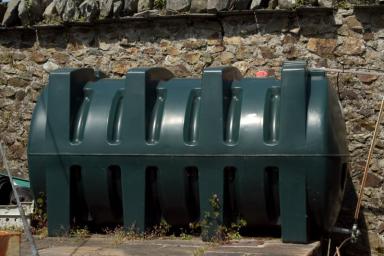Guide to oil tanks – when to replace and the regulations

What are the regulatory requirements for oil tanks and when do they apply?
Oil spillages can cause significant damage to the environment. From polluting waterways to killing trees with preservation orders, the damage can be extensive and often irreparable. Whilst home insurance companies do cover oils tanks, their terms are increasingly strict because the clean-up costs are so expensive. Oil users have legal responsibilities for maintaining their oil tank. This Guide takes you through the regulatory requirements for your existing oil tank and a new oil tank installation. For more try our guide to Domestic oil spills and insurance.
New Oil Tanks
![]()
New domestic oil tanks must meet minimum standards as set down by building control regulations. These cover the proximity of the tank to buildings and boundaries, type of tank, who can certify the installation and the oil supply pipe. Average installations range between £2,200 - £3,000 depending on size. For more on prices read our guide: How much does a new oil tank cost?
Existing Oil Tanks
![]()
Unlike gas appliances, there are no mandatory requirements for upgrading a non-compliant tank because it is ‘unsafe’. However it is against the law to cause pollution and you can face large fines and criminal prosecution for failing to prevent a spill. Oil Spill Insurance is a must and most policies require an annual inspection by an Oftec engineer and all maintenance and remedial works identified are carried out.
Your duties as an oil tank owner
Regulatory responsibilities
When your oil boiler is serviced or you are arranging a replacement boiler, the attending engineer will carry out an inspection of the oil tank. The engineer must notify you of any defects and non-compliances and make recommendations for rectifying. For example, the body of the tank is in poor condition/rusting, the tank is located too close to a shed or it is not bunded and next to a drain. The most immediate and common problems are:
- Leaks from a deteriorating tank or oil line that will require environmental clean-up;
- Water ingress into the tank. Water in the oil can transfer dirt from the tank into the boiler. It can also freeze in cold weather and block the line.
Unlike Gas Safe regulations, you are not at risk of being cut off due to a defective tank nor are you required to make the tank compliant with current standards when replacing the boiler. In extreme cases the attending engineer may refuse to change the boiler without the changing the tank, but Oftec do have not powers to force you and you may find another Oftec engineer who will.
Environmental responsibilities
However, anyone who stores heating oil has a duty to ensure that the substance will not release into the environment. As an oil tank owner, you are directly responsible for the clean-up costs of any spills that occur and any consequential damage.
Oil tanks and spills are covered under your home insurance but the terms can be quite limited. Home insurers will cover loss of metered oil due to theft or accident, but not due to wear and tear or gradual leaks. Clean up costs for oil spills are only covered in very limited circumstances and again not for gradual leaks. In all cases you are required to keep the tank in good repair and declare any problems at the outset.
For more a comprehensive cover it is best to take out a specialist Oil Spill policy. This scope for claims is much wider but the insurer will require an annual inspection of the tank by an Oftec engineer and that any recommended works are carried out within 60 days – see our Guide to domestic heating oil spills and insurance.
If you are advised to replace your tank because your boiler is at risk of irrevocable damage or the tank is in such poor condition a leak is imminent, then the costs of preventative works in the short term will be much less than the cost of the damage caused as a consequence of not replacing. If the cost is too much, you might want to consider using a supplier that offers stage payments for a new tank as part of their oil supply services (see below).
Oil Tank Regulations
Selecting the right type of oil tank
Whilst it is possible to fit a single skin tank, most new domestic tanks are integrally bunded. It is much more straight forward to fit an integrally bunded tank as it reduces the risk of non-compliance with an unsurveyed water source. The three main types of tank are as follows:
Single Skin:
older style tanks, often made of steel. If they are at risk of polluting a water way then they must have a secondary ‘bund’. For single skin tanks this takes the form of a reinforced concrete or masonry bund (see below).
Integrally bundled:
most modern, domestic tanks are integrally bunded. This means that an outer containment forms part of the tank construction removing the requirement for a masonry or concrete containment.
Double bunded:
mostly used in underground commercial applications.
Siting the tank
Building control and environmental regulations give specific guidance for how a new oil tank should be installed and sited. Your attending engineer will be able to give you specific guidance according to your circumstances. The following requirements are given as a guide:
External siting requirements:
- 760mm from a boundary
- If you wish to screen your tank (which is advised to help prevent fuel theft) then a screen can be erected no closer than 600mm from the tank (unless it forms part of the boundary in which case it must be 760mm).
- 1.8m away from a non-fire rated building or structure, e.g. garden shed
- 1.8m away from openings such as doors or windows in a fire rated structure, e.g. house or brick out building
- 1.8m away from the oil boiler’s flue terminal
- 50 meters away from a spring, well or borehole
- 10 meters away from a water course e.g. river, stream, pond, drain
- Anywhere spilt oil could enter drains, manholes or pollute ground water
- Anywhere that is as risk of flooding
Base requirements:
- The tank must be sited on a fireproof base (such as concrete or stone slabs)
- The base must be at least 50mm thick - if using paving slabs - on a compact and blinded hardcore base OR 100mm or concrete
- It must extend 300mm around the perimeter of the oil storage tank. (This prevents the tank from becoming overgrown and fire spreading across the ground to the tank.)
Internal siting requirements
- The tank must be under 3,500 litres to store inside a building
- The tank must be contained in a one-hour fire resistant chamber within the building
- The building must contain nothing but the tank.
- The building must be vented and the boiler sited at the lowest possible point.
Other considerations:
- If you are more than 30m from a road a remote refill pipe is provided for fuel suppliers to connect onto. Due to the increased risk of spillage, the tank should be integrally bunded with a device to prevent overfilling such as an alarm.
Underground tanks:
- Underground storage tanks are available but onerous to install due to the environmental risks of contamination from leaks. This is a specialist area and it is recommended that only a specialist company advises on and carries out the work.
Oil supply pipes
Specific regulations govern the installation of oil supply pipes in order to prevent leakages and ensure system reliability. Any air gaps or loss of oil supply due to a faulty installation will result in the boiler cutting out and an engineer visit to reset it.
Oil pipe specification
- Modern oil pipes are made of a plastic-coated soft copper tube without joins that can be bent. These can run over or underground.
- Plastic pipes can also be used but only underground.
- The pipe should ideally take the most direct route between the tank and the burner.
Over ground pipes
- For over ground pipes, they should avoid high and low points in the pipework, trip hazards or contact with anything likely to damage the pipe and joints.
- External pipe should be supported by purpose made clips and attached to permanent structures, i.e. a wall, not a shed or fence.
Buried pipes
- For buried pipes, the trench should be:
- 450mm deep with 40mm of compacted sand laid on the bottom.
- A further 40mm of compacted stand should be backfilled over the pipe and topped with builder’s grade plastic.
- The trench should be backfilled with dirt to 150mm below the surface and an oil warning marker tape is laid along the trench.
Transition into buildings
- Oil pipes should be sleeved with for example another plastic pipe as it enters the building
- The pipe should rise externally before entering the building and a remote fire valve fitted as it enters
- The fire valve will cut the oil supply to the boiler if the temperature rises above 85 degrees.
- Fire values must be fitted externally to all new boiler and tank installations. They can be fitted internally to existing oil boiler installations.
Protecting your supply from theft
Oftec provide some useful guidance for guarding against theft, a few practical solutions are summarised here:
- Lock the tank via the inspection cover or retro fit a lockable filler cap
- Install an electronic sensor to monitor oil levels via your phone for sudden drops
- Screen the tank from the road (must meet minimum clearances)
- Make the tank clearly visible from your home
- Check your home contents covers oil theft
Does my tank installer need to be Oftec registered?
The short answer is that yes, the attending engineer must be OFTEC registered, or registered with another ‘competent persons scheme’, in order to sign off the works to the tank for building control purposes.
Competent person’s schemes, such as OFTEC, mean that registered engineers can certify that work they undertake on any part of the oil boiler or tank installation are compliant with building control. Their certification is passed on to your building control.
It is of course possible for a non-competent person to install the tank and for you to notify building control yourselves. The works will be inspected by building control directly before they are signed off. However it is highly recommended the works are carried out a by trained person registered with an industry body. The consequences of an oil spill have been highlighted above.


